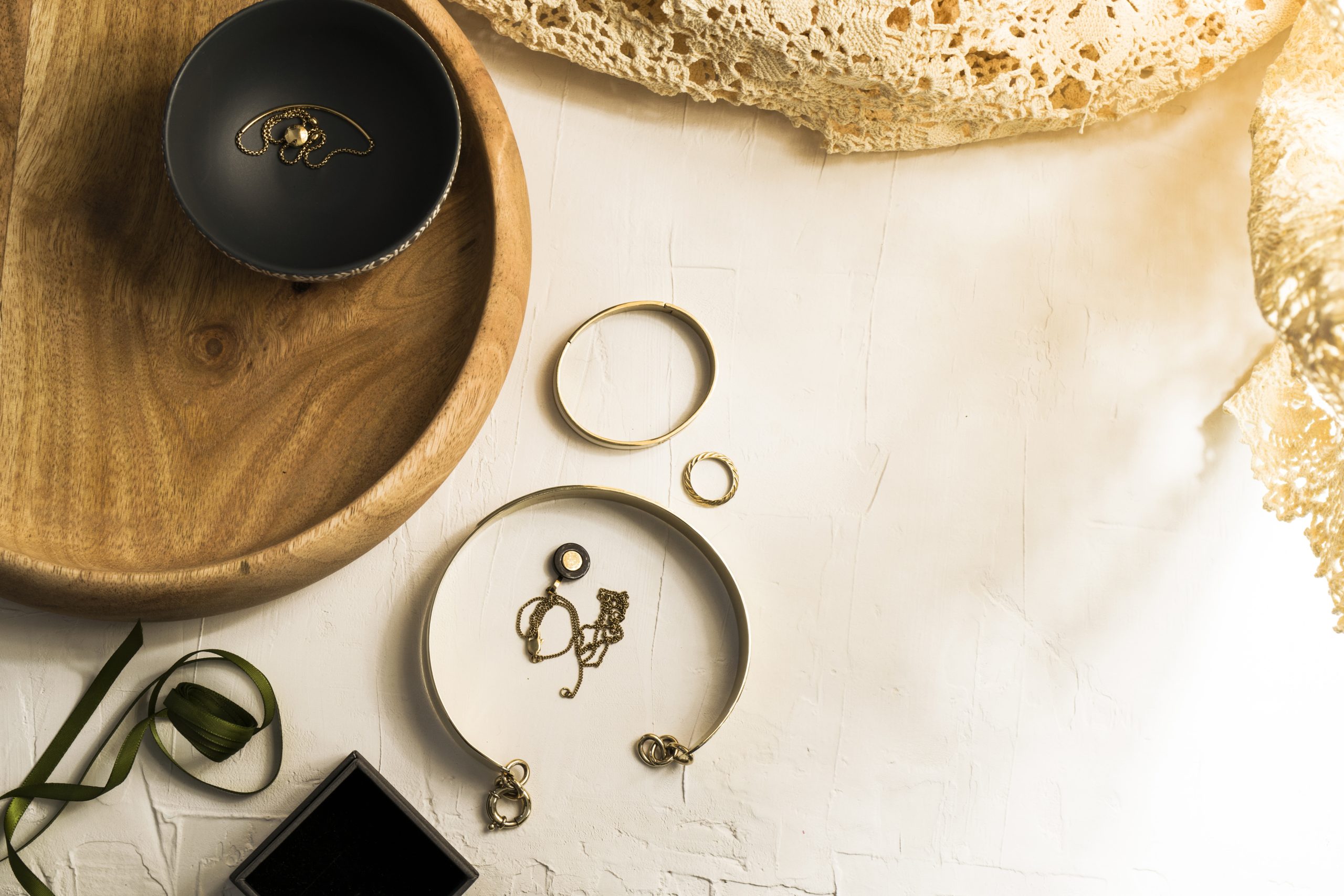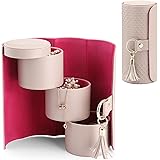Have you ever wondered about the amount of gold required to make those beautiful gold bangles that adorn your wrists? In this article, we will explore the fascinating world of gold bangles and uncover the answer to the age-old question – just how much gold is needed for bangles? Join us as we delve into the intricacies of gold crafting and discover the secrets behind this timeless accessory.
Giggle & Honey Musical Jewelry Box for Girls - Kids Jewelry Box, Unicorn Toys for Girls 4-6, Unicorn Gifts, 6 x 4.7 x 3.5 in
$16.99 (as of December 19, 2025 19:38 GMT +00:00 - More infoProduct prices and availability are accurate as of the date/time indicated and are subject to change. Any price and availability information displayed on [relevant Amazon Site(s), as applicable] at the time of purchase will apply to the purchase of this product.)Homde Synthetic Leather Huge Jewelry Box Mirrored Watch Organizer Necklace Ring Earring Storage Lockable Gift Case (White + Gold)
$49.99 (as of December 19, 2025 19:38 GMT +00:00 - More infoProduct prices and availability are accurate as of the date/time indicated and are subject to change. Any price and availability information displayed on [relevant Amazon Site(s), as applicable] at the time of purchase will apply to the purchase of this product.)bussdis 3 Tier Bracelet Holder Display - Detachable T Bar Beige Velvet Bracelet Holder, Jewelry Holder Organizer for Bracelet, Necklace, Earrings, Rings
7% OffJAMEND CLXP Lotus Leaf Shape Decorative Ring Tray, Small Key Bowl, Ceramic Trinket Tray Jewelry Dish Organizing Necklace Earrings, Home Decoration for Mom Best Friend Sister, Pink.
$7.98 (as of December 19, 2025 21:01 GMT +00:00 - More infoProduct prices and availability are accurate as of the date/time indicated and are subject to change. Any price and availability information displayed on [relevant Amazon Site(s), as applicable] at the time of purchase will apply to the purchase of this product.)Vlando Viaggio Small Jewelry Case Box, Travel Essential Accessories for Women, Gifts for Travelers Couples Mom Friends, Bridesmaid
14% Off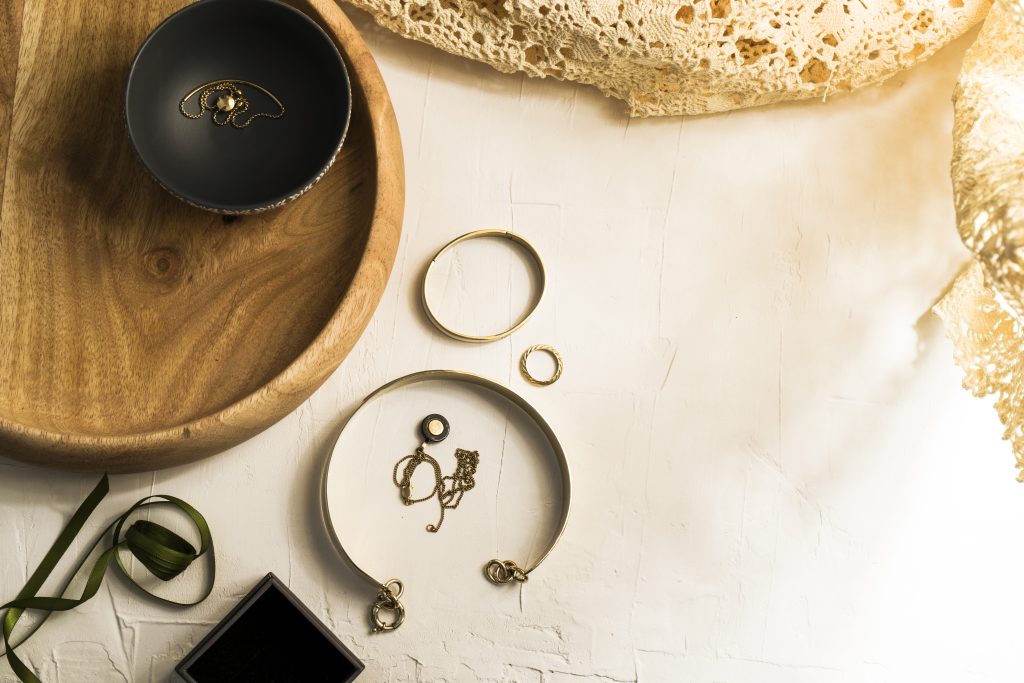
Factors that Determine Gold Requirement for Bangles
When it comes to determining the gold requirement for bangles, there are several factors to consider. The size of the bangle, the design and style, the weight, the gold purity, and the presence of gemstone embellishments all play a role in determining how much gold is needed. By understanding these factors and their impact on the gold requirement, you can make more informed decisions when designing or purchasing bangles.
Size of the Bangle
One of the primary factors that determine the gold requirement for bangles is the size of the bangle itself. Different sizes require varying amounts of gold to create. Generally, bangles are available in standard sizes, including small, medium, and large. However, if you require a bangle that doesn’t fit into these standard sizes, additional gold may be needed to accommodate the customization.
Design and Style
The design and style of the bangle also have a significant impact on its gold requirement. Sleek and thin bangles typically require less gold compared to broad and heavy ones. Similarly, stacked or layered bangles may require more gold due to their intricate design. Bangle sets, which comprise multiple bangles worn together, will also have a higher gold requirement compared to individual bangles.
Weight of the Bangle
The weight of the bangle is another crucial factor to consider when determining how much gold is required. Heavier bangles, which contain more gold, will naturally have a higher gold requirement compared to lighter ones. However, it’s essential to strike a balance between the desired weight and the overall look and feel of the bangle. Too heavy, and it may become uncomfortable to wear, while too light, and it may lack the desired presence and durability.
Gold Purity
The purity of the gold used in the bangle also plays a significant role in determining the gold requirement. Generally, gold bangles are available in 24K, 22K, and 18K purity options. The higher the purity, the more gold is required to create the bangle. Therefore, if you opt for a higher purity like 24K, you will need more gold compared to a bangle made with 18K gold.
Gemstone Embellishments
Lastly, if you choose to incorporate gemstone embellishments into your bangle design, it will impact the gold requirement. The size, type, and number of gemstones used will determine how much gold is needed to securely hold and display them. Solitaire bangles with a single large gemstone will require less gold compared to bangles with multiple small gemstones or bangles with large gemstones that cover more surface area.
Calculating Gold Requirement for Different Bangle Sizes
Now that we have discussed the various factors that influence the gold requirement for bangles let’s delve into specific calculations for different bangle sizes.
Standard Bangle Sizes
Before we explore the gold requirement for various sizes, it’s essential to understand the standard bangle sizes. Small bangles typically have a circumference of around 6.9 inches, medium bangles have a circumference of around 7.5 inches, and large bangles have a circumference of around 8.1 inches. These sizes serve as a starting point, but customizations can be made to accommodate individual preferences.
Gold Requirement for Small Bangles
For small bangles, which have a circumference of around 6.9 inches, the gold requirement will vary based on the factors discussed earlier. On average, small bangles require around 12 to 15 grams of gold. However, this estimate can fluctuate depending on the design, weight, and gold purity.
Gold Requirement for Medium Bangles
Medium-sized bangles, with a circumference of around 7.5 inches, generally require slightly more gold compared to small bangles. On average, medium bangles require approximately 15 to 20 grams of gold. However, as with any bangle size, the specific design and style, weight, gold purity, and the presence of gemstone embellishments will influence the overall gold requirement.
Gold Requirement for Large Bangles
Large bangles, with a circumference of around 8.1 inches, tend to have the highest gold requirement. On average, large bangles can require approximately 20 to 25 grams of gold. However, it’s crucial to remember that these estimates are generalizations, and the actual gold requirement can vary depending on the individual factors unique to each bangle.
Gold Requirement for Bangle Designs and Styles
Beyond the size considerations, the design and style of the bangle also affect its gold requirement. Let’s explore how different designs and styles impact the amount of gold needed.
Sleek and Thin Bangles
Sleek and thin bangles, which are delicate and slender in appearance, generally require less gold compared to their broader counterparts. These bangles offer a minimalistic and elegant appeal while utilizing a smaller amount of gold. If you prefer a dainty look or if you’re looking to reduce the gold requirement, sleek and thin bangles are a great option.
Broad and Heavy Bangles
Broad and heavy bangles, on the other hand, require more gold due to their larger surface area and overall weight. These bangles often feature intricate designs, patterns, or motifs that require additional gold to create the desired aesthetic. If you’re drawn to bold and statement-making bangles, be prepared for a higher gold requirement as compared to sleek and thin designs.
Stacked or Layered Bangles
Stacked or layered bangles, which involve wearing multiple bangles together, can require more gold compared to individual bangles. The gold requirement for stacked bangles is influenced by the total number of bangles in the set, their individual weights, and the desired look. If you opt for a stacked bangle look, keep in mind that the gold requirement will increase accordingly.
Bangle Sets
Bangle sets primarily consist of multiple bangles that are designed to be worn together. These sets can include various sizes, designs, and styles, offering a versatile and cohesive look. The gold requirement for bangle sets will depend on the number of bangles in the set, the sizes of each bangle, the design elements, and any additional gemstone embellishments. It’s important to consider these factors when purchasing or designing a bangle set to ensure you meet your desired gold requirement.
Gold Purity and its Impact on Gold Requirement
Another significant factor to consider when determining the gold requirement for bangles is the purity of the gold used. Gold bangles are available in different purities, typically including 24K, 22K, and 18K. Let’s explore how each purity level impacts the gold requirement.
24K Gold Bangles
24K gold is considered the purest form of gold, with a purity of 99.9%. However, due to its softness and malleability, it may not be the ideal choice for bangles. Since 24K gold is very soft, it may not withstand the everyday wear and tear associated with bangle usage. Additionally, due to its higher purity, 24K gold requires more gold to achieve the desired size, weight, and structural integrity.
22K Gold Bangles
22K gold, with a purity of 91.7%, is a common choice for gold bangles. It offers a good balance between purity and durability. 22K gold requires slightly less gold compared to 24K gold to achieve the same size and weight. This makes it a popular choice for those looking for high-quality gold bangles that are also durable and suitable for regular wear.
18K Gold Bangles
18K gold, with a purity of 75%, is another option to consider for gold bangles. It contains a higher percentage of other metals compared to 22K or 24K gold, making it more durable and resistant to scratches and dents. Due to its lower gold purity, 18K gold requires less gold compared to higher purity options to achieve the desired bangle size and weight.
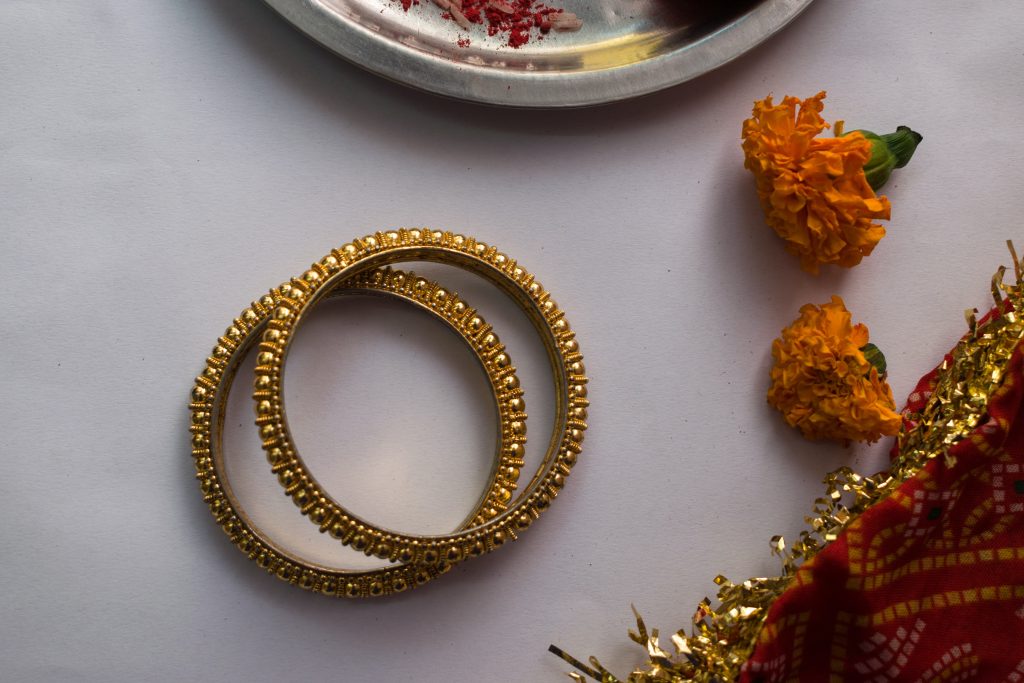
Gold Requirement for Bangles with Gemstone Embellishments
If you’re considering bangles with gemstone embellishments, it’s important to factor in the gold requirement for securely holding and showcasing the gemstones. Let’s explore how different types of gemstone embellishments impact the gold requirement.
Gold Requirement for Solitaire Bangles
Solitaire bangles, featuring a single large gemstone, generally require less gold compared to bangles with multiple gemstones. The gold requirement for solitaire bangles will depend on the size, cut, and quality of the gemstone. The setting used to hold the gemstone will also contribute to the overall gold requirement.
Gold Requirement for Bangles with Small Gemstones
Bangles adorned with small gemstones, such as diamonds or colored gemstones, may require additional gold compared to solitaire bangles. The gold requirement will depend on the number of gemstones used, their size, cut, and quality, as well as the intricacy of the design. If you prefer the sparkle and color of multiple gemstones, be prepared for a higher gold requirement.
Gold Requirement for Bangles with Large Gemstones
Bangles featuring large gemstones that cover a significant portion of the bangle’s surface area will naturally require more gold. These bangles are designed to showcase the gemstone prominently, so additional gold is needed to create a secure and visually appealing setting. The gold requirement for bangles with large gemstones can vary depending on the specific size, cut, and quality of the gemstone, as well as the desired design and style.
Tips to Minimize Gold Usage While Designing Bangles
If you’re looking to minimize the gold usage when designing bangles, here are a few tips to consider:
Consider Lightweight Designs
Opting for lightweight designs can help reduce the overall gold requirement. Sleek and thin bangles or bangles with simpler and minimalistic designs typically utilize less gold compared to heavier and more intricate designs. By focusing on lighter designs, you can achieve your desired look while using less gold.
Opt for Hollow Bangles
Hollow bangles, which feature an empty interior, offer an opportunity to reduce the gold requirement without compromising on the external appearance. Hollow bangles can be made by carefully crafting the outer shell while maintaining the desired thickness. This technique helps reduce the overall weight and gold usage while still creating a visually appealing bangle.
Choose Lower Gold Purity
Opting for a lower gold purity, such as 18K instead of 24K, can help reduce the gold requirement. Lower purity gold contains a higher percentage of other metals, which can help increase the durability and reduce the overall gold usage. This approach allows you to strike a balance between gold purity, durability, and the desired gold requirement.
Use Gemstone Alternatives
If you want to incorporate the beauty and color of gemstones but want to minimize the gold requirement, consider using gemstone alternatives. Lab-created gemstones, cubic zirconia, or other synthetic gemstones can offer similar visual effects while requiring less gold compared to natural gemstones. This allows you to achieve your desired look while reducing the overall gold requirement for the bangle.
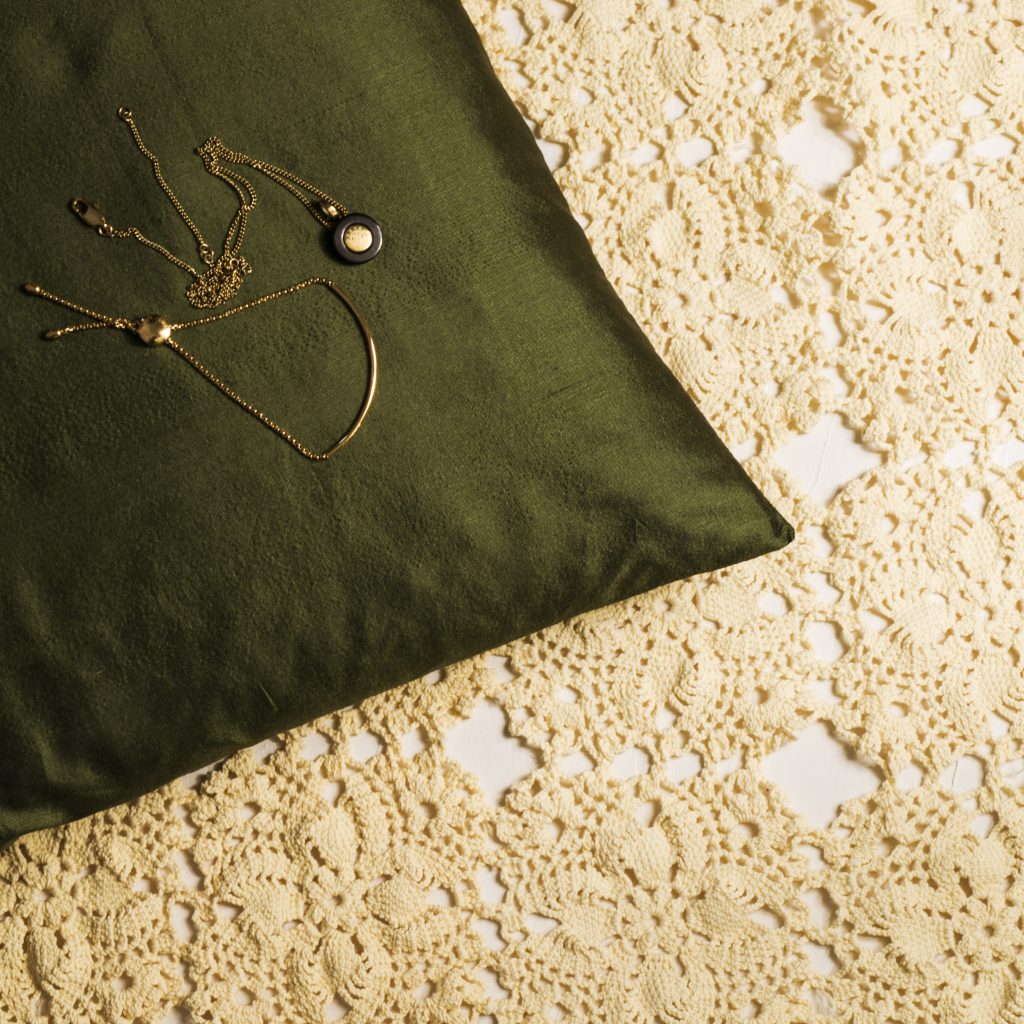
Factors that Influence Gold Prices
Understanding the factors that influence gold prices is essential when considering the cost of bangles and the overall gold requirement. Here are some key factors to consider:
Global Economic Factors
Gold prices are influenced by global economic factors such as inflation, interest rates, geopolitical uncertainties, and the overall health of the global economy. Economic conditions and market trends impact the demand for gold, which, in turn, affects its price. Keeping an eye on these economic factors can help you anticipate potential fluctuations in gold prices.
Demand and Supply
The demand and supply dynamics of gold play a significant role in determining its price. High demand and limited supply can drive up the price, while low demand and abundant supply can lead to price decreases. Factors such as consumer buying patterns, jewelry industry demand, and investment demand all contribute to the overall demand and supply of gold.
Market Speculation
Market speculation and investor sentiment can also impact gold prices. Speculators and investors often trade gold futures and options, which can create fluctuations in the market. Rapid buying or selling of gold in response to market predictions or investor sentiment can cause short-term price volatility.
Inflation and Currency Value
Inflation and currency value are closely linked to gold prices. When inflation rises or when the value of a currency decreases, gold prices tend to increase. Gold is often considered a safe-haven asset during times of economic uncertainty or inflationary pressures, leading to increased investment demand and higher prices.
Understanding the Gold Price Calculation
To better understand the cost of bangles, it’s important to grasp how gold prices are calculated. Here are some key elements to consider:
Gold Price per Gram
Gold prices are typically quoted in terms of the price per gram. This price is influenced by various factors, including the global spot price of gold, market conditions, and any additional charges imposed by jewelry retailers. The gold price per gram serves as a starting point when determining the cost of the gold required for bangles.
Gold Weight Conversion
Once you have the gold price per gram, you can calculate the cost of the gold required for bangles by multiplying the gold weight by the gold price per gram. The weight is usually measured in grams but can be converted into other units, such as ounces or kilograms, depending on the specific gold price and weight conversion rates used in your region.
Additional Charges and Taxes
In addition to the cost of the gold itself, it’s important to consider any additional charges and taxes that may be imposed when purchasing or customizing bangles. These charges can include labor fees, design fees, taxes, and other overhead costs associated with the manufacturing process. These additional charges can add to the overall cost of the bangles.

Gold Bangles as an Investment
Gold bangles not only serve as beautiful accessories but can also be considered as an investment. Here are some key points to consider when viewing gold bangles as an investment:
Gold as a Safe Haven
Gold has long been considered a safe-haven asset. During times of financial instability or economic uncertainties, gold tends to retain its value and can even appreciate. Investing in gold bangles allows you to enjoy the aesthetic pleasure of wearing them while potentially benefitting from their value as an investment.
Potential for Appreciation
Gold has a long history of appreciating in value over time. While price fluctuations are common, the overall trend of gold prices has shown an upward trajectory. By investing in gold bangles, you have the potential to benefit from any future appreciation in gold prices.
Longevity and Durability
Gold bangles, when well cared for, can last for generations. Gold is a durable and long-lasting metal, making it a reliable investment option. Unlike other forms of investment, such as stocks or bonds, gold bangles offer tangible value that can be enjoyed and passed down as heirlooms.
Considerations for Investment Bangles
When purchasing gold bangles as an investment, there are a few additional factors to consider. Opting for higher purity gold, such as 22K or 24K, can potentially result in higher resale value due to the higher gold content. Additionally, choosing classic and timeless designs can ensure that the bangles remain desirable, regardless of changing fashion trends.
Conclusion
When it comes to determining the gold requirement for bangles, several critical factors come into play. The size of the bangle, the design and style, the weight, the gold purity, and the presence of gemstone embellishments all influence how much gold is needed. By considering these factors and following some tips to minimize gold usage, you can design or purchase bangles that meet your desired requirements. Understanding the factors that influence gold prices and the process of gold price calculation allows you to make more informed decisions about the cost and potential investment value of gold bangles. Whether you’re purchasing bangles as a fashion statement, a sentimental accessory, or as an investment, gold bangles offer a timeless and versatile option that can be enjoyed for years to come.

